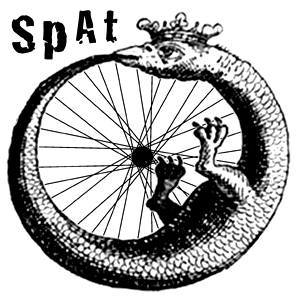I’ve been living on hand-weaving, for over thirty years. This may be answer to the classic question: “Can one live by weaving?” In my case, however, weaving is not really a job. It’s much less and much more: it’s more of an existential than economic enterprise, and certainly not exempt from madness. But, as Hölderlin claims, madness is the essence of the human spirit. Weaving is in fact as old as man. In the prehistory of human evolution, weaving is the empirical paradigm that triggers intellectual development: the famous cerebral hardware of the Human Spirit.
Before I was a young philosopher, now I’m an old weaver... and yet they still call me Professor by virtue of that degree that I never used. Thus I founded my Faculty of Weaving in a minuscule village in Umbria. There’s nothing to laugh about: Italy is a country of universities and of country universities. In the Faculty we carry out a lot of research, both experimental and related to the textile workshop. Here we test out strange textile fibres, we recycle the industrial (and semantic) waste of the Fashion system. We weave improbable prototypes, that can nevertheless be sold as one-off pieces to the supporters of the Faculty that use them as accessories, clothing and art. We don’t have any
other contributions. We also perform teaching in the Faculty of Weaving, without mapping out projects, simply through textile practice: the Indo-European rustic loom, the West African Kente loom, the Turkish-Berber tribal loom... and BrandaMaglia: an original knitting technique that uses discarded bed springs (Branda = bed, Maglia = knit). I can’t boast that I invented the original implement of the BrandaMaglia, I simply discovered it among the waste of the Opulent Modern Society. Just as, without ever creating nothing from nothing, I recover the yarns of cast-off fashions to assemble them with Missoni effects. But a good while before Missoni arrived on the scene, the anonymous race of hand-weavers were already combining cast-off yarns with the most amazing colour effects. Without ever creating nothing from nothing, I recover the high-fashion fabrics, I tear them into strips and recycle them on the loom: just like the race of hand-weavers. But I sign everything, I display and document, like a contemporary artist, and I publish all my research on the web, like all democratic scientists (http://porchiano.blogspot.com). Even the frames of the junked beds, after the BrandaMaglia springs have been removed, are recycled as weaving looms, used to knot up a tribal carpet from strips of industrial fabric, like the aforementioned anonymous race of weavers. Naturally this Faculty of Weaving is not really institutional, but purely situationist. It is however as proud and ancient as man, the cultural heritage of all humanity, threatened with extinction by its stupidity. But fortunately, like the Benedictines, we transcribe the codices of weaving, while waiting for the Barbarians to calm down and everyone to be smiling again, all adorned in the most splendid textiles. A far cry from Volta & Gabbana, Offendi, Versacci or Mosquito... get it?
 <<< FOTO ALBUM Bicycle and dragon
<<< FOTO ALBUM Bicycle and dragon Carpet created in Florence (as the title states) at the CPA in the “Tessere Liberi” workshop. It is a “rag rug”, that is a carpet made of rags, a classic variety of popular art where the knots that form the pile and/or the design are made not of wool but of strips of recycled cloth. The loom used to weave the carpet is also recycled. It was an abandoned old bed frame, retrieved by the anarchist Signori (VIDEO), a dustman who supplied Tessere Liberi with the various equipment and textile fibres. As regards the iconography, that is the designs (which the critics are always so ravenous for), we can see a number of bicycles. Here we’re talking about the non-violent, ecological struggles of the Florentine city cyclists, with cycle workshops and Critical Mass. All struggles contingent, even physically, with the people who were there knotting the rug, and who even designed a dragon on it (as the title of the work indicates). Is that because the Dragon signifi es good luck? But a rug is a rug is a rug: it doesn’t signify a cosmos, it is one.
Luciano Ghersi studied in Genoa, where he was born in 1952 and where he took a degree in Philosophy in 1975. Since 1977 he has been practising and writing about weaving; he wrote L’Essere e il Tessere (Being and Weaving) in 1992, as well as numerous articles. He wove using a simplified rustic loom, modified so that he could weave standing up, after which he turned to the vertical Sardinian loom, the flying shuttle loom, again with two pedals, looms that he built himself using recycled objects and materials. He combines colours and materials with great flair, since he utilises anomalous yarns often far from orthodox: anything that can be rendered threadlike, even barbed wire, animal material, books and lots of other objects. He prefers not to define his graphic projects in advance, creating textiles that pursue the formal and chromatic juxtapositions proper to textile patterning. In the summer of 1998 he created Global Home, which accompanied the exhibition events of the summer like a sort of work in progress. The subtitle was “nomadic workshop of public art”, and it consisted of the structure of an Indian tent made with 6-metre tubes, which was then covered by a strip of fabric that was woven on the spot by the visitors, who brought with them anomalous waste materials that they then wove on a loom constructed by Ghersi using scrap iron. In 2007 he launched the Faculty of Weaving in Porchiano Del Monte, in the province of Terni, with the idea of initiating the profane into the sublime art of Weaving, which is as necessary to Man (also understood as Woman) as the Air that he breathes.







1 comment:
Interesting stuff. There is a resonance here. -Jayne
Post a Comment